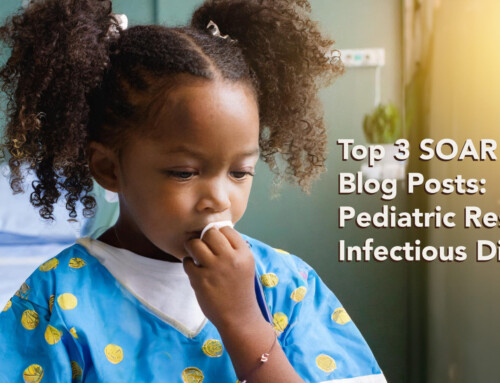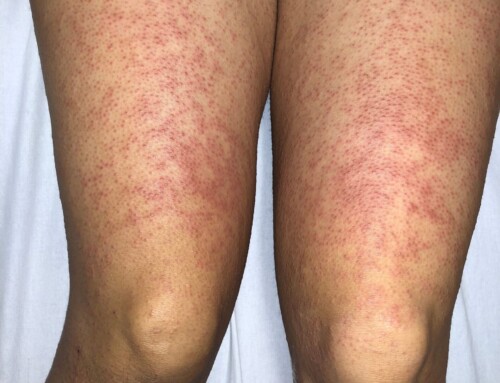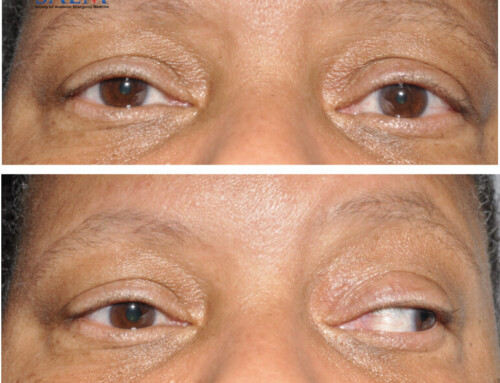
In July 2022, a 32-year-old male with a past medical history of HIV (on antiretroviral therapy, CD4 390, viral load undetectable) presented to the emergency department with constitutional symptoms and a rash for 4-5 days. His symptoms included malaise, body aches, subjective fevers, a sore throat, tender, swollen neck glands, body rash, and irritation of his left eye. He also noticed fluid-filled vesicles on his face, neck, trunk, and extremities. He denied travel outside the U.S. but reported a recent trip to New Orleans. He denied any new sexual partners or known exposure to individuals with similar symptoms.
Vitals: BP 135/83; Pulse 104; Temp 100.2 °F (37.9 °C); Resp 22; SpO2 99%
Constitutional: Alert, no acute distress
HEENT: 1×1 mm raised lesion to the left medial canthus/caruncle. No appreciated LAD. Oropharynx is clear and moist, and mucous membranes are normal.
Cardiovascular: Tachycardia, regular rhythm, and normal heart sounds.
Pulmonary: Breath sounds normal, unlabored respirations.
Abdominal: Soft. Non-tender.
Skin: Numerous 5-6 mm erythematous macules, bland fluid-filled vesicles, and umbilicated lesions throughout the face, neck, trunk, and extremities.
Complete Blood Count (CBC): WBC: 19.5 10^3/mcL, Hemoglobin: 15.2 gm/dL, Hematocrit: 43.6%, Platelet count: 325 10^3/mcL
Comprehensive Metabolic Panel (CMP): Within normal limits
RPR titer: Reactive, 1:4
Syphilis antibody IgG and IgM: Positive
Orthopoxvirus DNA: Pending
HIV RNA: Pending
The patient has Monkeypox with involvement of the caruncle of the left eye. The patient tested positive for non-variola orthopoxvirus DNA. Ophthalmology was consulted and did not find any other signs of compromise to the eye and recommended treatment with artificial tears. The patient received 14 days of Tpoxx. The patient’s eye lesion and symptoms resolved and he was discharged on hospital day eight.
Ocular lesions are a rare presentation of the monkeypox virus. There is limited literature documenting eye involvement and pictographic examples of its presentation. During the current outbreak, ocular involvement has been used as a criteria for hospital admission. The most commonly seen ophthalmologic lesions include a vesicular rash of the orbital and periorbital skin (25%), focal conjunctiva lesions, blepharitis, and conjunctivitis. Rarely, lesions can process to corneal ulcerations, keratitis, and vision loss. Given the late risk of vision loss in cases of ocular manifestations, clinicians should be aware of the varied presentation of ocular lesions associated with the monkeypox virus.
Take-Home Points
- While rare, ocular involvement of Monkeypox is associated with vision loss, and should be promptly identified and addressed by a clinician.
- If there is ocular involvement of primarily cutaneous pathology, a thorough eye exam is indicated in the initial assessment of the patient.
- Abdelaal A, Serhan HA, Mahmoud MA, Rodriguez-Morales AJ, Sah R. Ophthalmic manifestations of monkeypox virus. Eye (Lond). 2023 Feb;37(3):383-385. doi: 10.1038/s41433-022-02195-z. Epub 2022 Jul 27. PMID: 35896700; PMCID: PMC9905463.
- Kumar N, Acharya A, Gendelman HE, Byrareddy SN. The 2022 outbreak and the pathobiology of the monkeypox virus. J Autoimmun. 2022 Jul;131:102855. doi: 10.1016/j.jaut.2022.102855. Epub 2022 Jun 25. PMID: 35760647; PMCID: PMC9534147.
- Thornhill, John P., et al. “Monkeypox virus infection in humans across 16 countries—April–June 2022.” N Engl J Med. 2022 Aug 25;387(8):679-691. doi: 10.1056/NEJMoa2207323. Epub 2022 Jul 21. PMID: 35866746.
Copyright
Images and cases from the Society of Academic Emergency Medicine (SAEM) Clinical Images Exhibit at the 2023 SAEM Annual Meeting | Copyrighted by SAEM 2023 – all rights reserved. View other cases from this Clinical Image Series on ALiEM.

Brittney Gordon, MD
Emory University School of Medicine

Latest posts by Brittney Gordon, MD (see all)
- SAEM Clinical Images Series: Not Your Usual Irritated Eye - March 11, 2024

Andrés Patiño MD, FACEP
Emory University Hospital Midtown

Latest posts by Andrés Patiño MD, FACEP (see all)
- SAEM Clinical Images Series: Not Your Usual Irritated Eye - March 11, 2024





